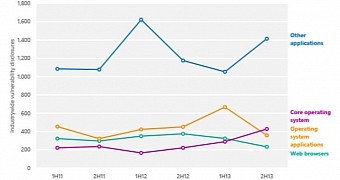Redmond-based technology giant Microsoft says that the number of security vulnerabilities found in software that’s currently available to users skyrocketed in the second half of 2013, with pretty much all products affected, be they applications or operating systems.
The company says in a detailed post on today’s security threats that vulnerabilities in applications, excluding web browsers and programs that are bundled by default in operating systems, increased by 34.4 percent in the same period and account for no less than 58.1 percent of all disclosures that took place in the second half of last year.
As far as the operating systems themselves are concerned, Microsoft says that things are even worse, with the number of vulnerabilities growing by 48.1 percent. This means that operating systems account for 17.6 percent of the disclosures for the period.
Vulnerabilities found in applications that are installed in operating systems decreased in the second half of 2013 by 46.3 percent, the company adds.
As far as browsers are concerned, data collected by Microsoft reveals that vulnerabilities found in these programs dropped by 28.1 percent and accounted for only 9.6 percent of all disclosures.
In terms of Microsoft’s software, the company says that figures remained pretty much the same, with slight differences in terms of operating systems.
“Microsoft vulnerability disclosures remained mostly stable, increasing from 174 disclosures in 1H13 to 177 in 2H13, an increase of 1.7 percent. The Microsoft percentage of all disclosures across the industry fell slightly over the same period, from 7.3 percent of all industrywide disclosures in 1H13 to 7.0 in 2H13, because of a larger increase in disclosures from other software publishers. This data highlights the importance of keeping all software up-to-date, not just Microsoft software,” the company explains in the report.
Microsoft itself has pledged to make its products more secure, so such enhancements have already been released for products such as Windows and Internet Explorer. At the same time, the company has promised to continue improvements in this regard, especially as far as the browser is concerned, with the next version of Internet Explorer expected to bring new features that could protect users when browsing the web.
Windows vulnerabilities are obviously a main concern, as Microsoft’s operating system is still powering more than 91 percent of the desktops worldwide.
For example, today the company has announced that the next patching cycle, which takes place on the second Tuesday of each month, will bring a total of 4 different security updates for its software, including a critical bulletin for the Windows operating system. Other products are also included in this rollout, among which Internet Explorer and Lync.

 14 DAY TRIAL //
14 DAY TRIAL //